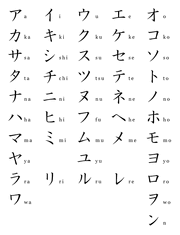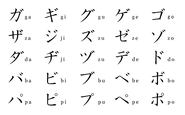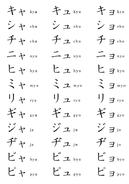
Katakana (片仮名, カタカナ or かたかな) is a Japanese syllabary, one component of the Japanese writing system along with Hiragana, Kanji, and in some cases the Latin alphabet. The word katakana means "fragmentary kana", as the katakana scripts are derived from components of more complex kanji.
In modern Japanese, katakana are most often used for transcription of words from foreign origin. For example, "television" is written terebi (テレビ). Similarly, katakana is usually used for country names, foreign places, and personal names. For example, America is written アメリカ Amerika (America also has its own kanji; Amerika (亜米利加) or for short, Beikoku (米国), which literally means "Rice Country".
Katakana are also used for onomatopoeia,words used to represent sounds. For example, pinpon (ピンポン), the "ding-dong" sound of a doorbell, would usually be written in katakana. Also, katakana is used for words the writer wishes to emphasize.
Technical and scientific terms, such as the names of animal and plant species and minerals, are also commonly written in katakana. Homo sapiens (ホモ・サピエンス), as a species, is written hito (ヒト), rather than its kanji 人.
Katakana are also often, but not always, used for transcription of Japanese company names. For example Suzuki is written スズキ, and Toyota is written トヨタ. Katakana are also used for emphasis, especially on signs, advertisements, and hoardings (i.e., billboards). For example, it is common to see ココ koko ("here"), ゴミ gomi ("trash") or メガネ megane ("glasses"), and words to be emphasized in a sentence are also sometimes written in katakana, mirroring the European usage of italics.
Katakana is also used for foreign words, or words borrowed from foreign languages.


